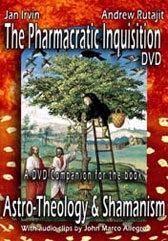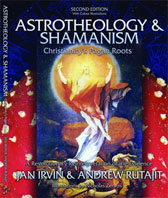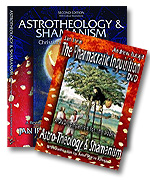This is a DVD companion for our book, Astrotheology & Shamanism. (Subtitles are available in Deutsch, Español, Nederlands, Português, Ελληνική, Polski, Français and Rусский click here for more information)
This DVD companion contains about 25% of the information presented in book, though it contains about double the images. The DVD is not meant to have detailed sources. If you are interested in the sources used for this video, please see the book Astrotheology & Shamanism.
The videos on this website are completely free to view and share. All we ask is that if you enjoy the videos to please buy the DVD and/or book, or make a donation to Gnostic Media, however large or small. We rely on donations in order to present this information for free to those who cannot afford to buy it or make a donation.
Thank you.
The entire DVD is available for free viewing below. Nothing has been edited out.
|
|
|
|
 |
The Pharmacratic Inquisition DVD List Price: $21.95 ea. + shipping Now Only $ 17.56! (Other regions S&H is included in price below). |
|
|
The definition of Pharmacratic Inquisition
Pharmaco-, a combining form meaning drug, medicine, or poison used in the formation of compound words: pharmacology, pharmacy, etc.
-crat, a combining form meaning ruler, member of a ruling body, or advocate of a particular form of rule, used in the formation of compound words: autocrat; technocrat. Cf. -cracy.
Inquisition, n. 1. an official investigation, esp. one of a political or religious nature, characterized by lack of regard for individual rights, prejudice on the part of the examiners, and recklessly cruel punishments. 2. any harsh, difficult, or prolonged questioning. 3. the act of inquiring; inquiry; research. 4. an investigation, or process of inquiry. 5. a judicial or official inquiry. 6. the finding of such an inquiry. 7. the document embodying the result of such inquiry. 8. (cap.) Roman Catholic Church A. a former special tribunal, engaged chiefly in combating and punishing heresy. Cf. Holy Office. B. see Spanish Inquisition.
Pharmacratic Inquisition nov. verb.
- The Christian persecution of archaic religions based on sacramental ingestion of entheogenic plants and the consequent personal access to ecstatic states; whose first great victory was the destruction of the Eleusinian Mysteries at the end of the fourth century; which then reached a gruesome climax in the persecution of witches in the Middle Ages; and which continues in today's Pharmacratic State in the guise of a public health 'War on Drugs.'
1994 Ott Ayahuasca Analogues, 12. May the Entheogenic Reformation prevail over the Pharmacratic Inquisition, leading to the spiritual rebirth of humankind at Our Lady Gæa's breasts, from which may ever copiously flow the amrita, the ambrosia, the ayahuasca of eternal life!
Source: The Age of Entheogens & The Angel's Dictionary by Jonathan Ott
Review
by Martin W. Ball, Ph.D., author and host of the Entheogenic Evolution Podcast
The Pharmacratic Inquisition is a provocative film from Gnostic Media that makes the argument that virtually all of the mythology, symbolism, and story of Jesus and related Christian traditions relate to two basic subjects: astrology and shamanism. For those unfamiliar with the evidence in support of this claim, this film can be truly eye opening and revolutionary.
Much of the material for this film rests upon the work of John Allegro. Allegro was one of the original scholars chosen to translate the Dead Sea Scrolls, ancient Christian texts that were discovered in Qumram near the Dead Sea in the middle of the 20th century. Unlike his colleagues, Allegro was not beholden to the Catholic Church and therefore was able to develop his theories and interpretations free from Catholic dogma. The result was the radical claim that Jesus was a psychoactive mushroom. In particular, Allegro argued that the mythology and symbolism surrounding the Christ figure all point to Amanita muscaria mushrooms, the iconic red and white mushroom so common in Christmas symbolism and imagery.
The amanita mushroom plays a central role in this film and is presented as the basis for the shamanic elements in Christianity. Amanitas have a long history of use among northern European and Siberian shamans – the very cultures from which the term “shaman” originates. Within these cultures, “shamanism” was synonymous with amanita use and knowledge of its psychoactive properties were well known throughout that region of the world. That the shamanic use of the amanita might influence Christianity should therefore not necessarily be a surprise, but the argument that Jesus actually is an amanita, and not a historical figure, is probably a surprise to most.
The film makes a compelling argument for this connection between Jesus and the amanita, and even psilocybin mushrooms, through the presentation of Christian symbolism, iconography, and imagery. When one looks closely at the Catholic Church, amanita symbolism appears to abound from the clothing of popes and cardinals to frescos, arch ways, and church architecture. Even the myths themselves, such as that of the Holy Grail, seem to fall within the category of amanita symbolism. Indeed, when the images are presented in this manner, the comparison to amanita becomes immediately obvious and difficult to argue against.
Even Santa Claus gets the amanita treatment in this film. Here the jolly old elf is presented in the context of northern European shamanism where, according to tradition, the shaman would dry his amanitas from a conifer tree and then visit the yurts of his community, entering through the smoke hole to bring gifts of sacred mushrooms to the people. It is not much of a stretch to see that these reindeer herding shamans were the iconic model for the fat red and white clothed Santa, who himself looks very much like an amanita mushroom.
In addition to the influence of shamanism and psychoactive mushrooms on Christianity, the film also investigates the relationship between astrology and astronomy to the Christ myth. Here the filmmakers provide compelling arguments for the correlation between the Christ myth and the Winter Solstice sky and the zodiacal ages, graphically demonstrating how such tales of the shining star, the three kings, and the death and resurrection of Jesus all fit within previously known facts about the night sky and the change of seasons.
Ultimately, the Pharmacratic Inquisition challenges many of the assumptions and beliefs we may have about Christianity and its central figures, providing provocative evidence that things are not as they seem within this tradition. If true, the question then becomes: does the Catholic Church still use amanita mushrooms secretly within the confines of the Vatican? Have they really been withholding this fundamental truth for two millennia, or have even they come to believe the myths that were created to both communicate and conceal the true identity of Jesus Christ? Watch this film and make up your own mind.


